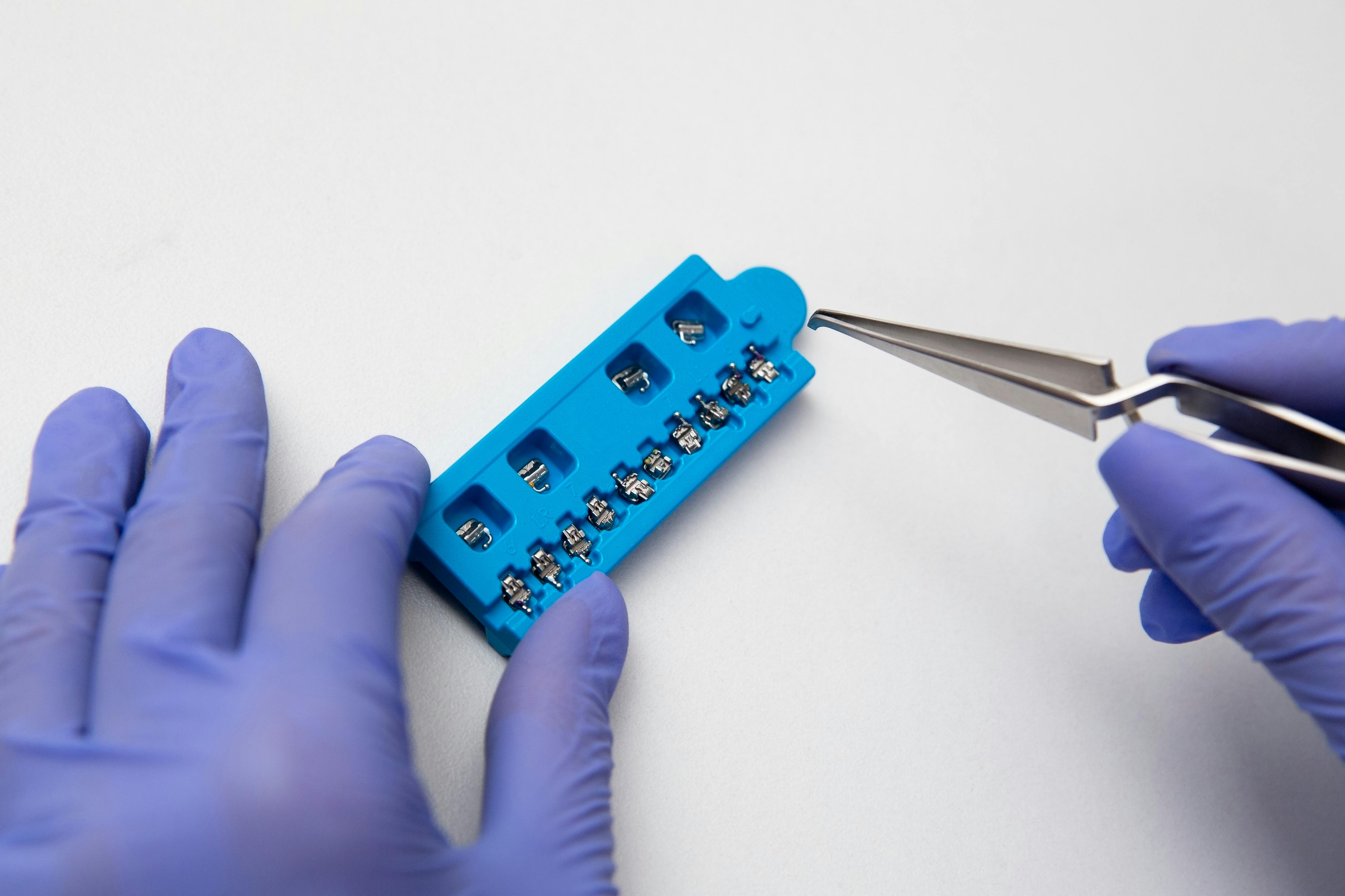Cleaning your teeth with braces can be a challenge, but it’s important to take the time to do it properly in order to maintain good dental hygiene and keep your teeth healthy. Braces make it harder to brush and floss properly, but there are some tips and tricks you can use that will help you get the job done quickly and thoroughly. In this article, we will discuss how to clean your teeth with braces, including the best brushing and flossing techniques to use.1. Begin by brushing your teeth with a soft-bristled brush and fluoride toothpaste. Make sure to brush in a circular motion around each tooth, both above and below the braces.
2. Use an interdental toothbrush or floss threader to clean in between the wires and brackets of the braces, as well as around the gum line. This helps prevent plaque buildup in hard-to-reach areas.
3. Rinse with water and use mouthwash for an extra cleaning boost (optional).
4. Finally, use a proxy brush, which is a special small brush designed to fit around braces, to really get rid of any plaque or debris that may have gotten stuck in your braces.
Brushing Teeth with Braces
Brushing your teeth with braces is an important part of maintaining good oral health. Proper brushing and flossing can help keep your teeth and gums healthy, even when you have braces. It is important to brush your teeth with braces at least twice a day, for two minutes each time. Doing so helps to remove plaque and food particles from around the brackets and wires of your braces.
When brushing with braces, it is important to use a soft-bristled toothbrush and fluoride toothpaste. You should aim to brush each tooth individually, paying special attention to the gum line, behind the brackets, and around the wires of your braces. If you are having difficulty reaching certain areas, try using an interdental brush or floss threader. Flossing is also an important part of keeping your teeth clean when you have braces; make sure to floss once a day.
Finally, it is important to visit your dentist or orthodontist regularly while wearing braces. They can check that your teeth and gums are healthy and that the treatment is progressing as planned. With proper care and regular visits to the dentist or orthodontist, you can keep your teeth clean and healthy while wearing braces!
Flossing Teeth with Braces
Flossing teeth with braces can be tricky, but it is an important part of keeping your teeth and gums healthy. Properly flossing your teeth while wearing braces can help remove food particles and plaque that lead to tooth decay and gum disease. If you do not floss regularly, you could end up with cavities or gum disease after the braces come off. Knowing how to floss correctly with braces will help ensure that your mouth stays healthy during treatment.
The first step to flossing your teeth with braces is to use a waxed dental floss or a special floss threader that is designed for use with braces. These products can help make it easier to slide the floss between the wires of your braces without damaging them. Start by cutting off a piece of floss about 18 inches long and wrap it around both middle fingers, leaving about an inch or two of slack in between them. Gently work the floss between each tooth, using a saw-like motion and curve the floss against each tooth as you go along. Make sure to go gently around the brackets as well, as they can be easily damaged if you aren’t careful.
Once you have worked the waxed dental floss between all of your teeth, use an interdental brush or proxybrush to clean around the brackets and wires of your braces. This will help remove any food particles or plaque that may have become stuck on them. Finally, rinse your mouth out with water or use a special mouthwash designed for people with braces to ensure that all food particles and bacteria are removed from your mouth.
Flossing teeth while wearing braces may seem like a daunting task at first, but it gets easier with practice. Taking the time each day to properly clean around and between your teeth will help keep your mouth healthy during orthodontic treatment and ensure that you have beautiful, healthy teeth when the braces come off!
Using Interdental Brush for Braces Cleaning
Braces are a great way to achieve the perfect smile, but they can be difficult to keep clean. Interdental brushes are specially designed to clean around braces and other orthodontic appliances. They are small, thin brushes with a tapered design that fits easily between teeth and around braces wires, brackets and other orthodontic hardware. Interdental brushes come in a variety of sizes and shapes that allow them to fit into hard-to-reach areas. They can be used in combination with floss to clean around braces and keep the teeth and gums healthy.
Interdental brushes are easy to use and should be part of your regular oral hygiene routine. Start by selecting an interdental brush size that fits comfortably between your teeth and around your braces wires. Insert the brush into each space between your teeth, moving it up and down gently several times. Use a back-and-forth motion if necessary to reach all surfaces of the tooth between brackets or bands. Gently work the brush along each wire until it is clean before moving on to the next space between your teeth.
It is important to use interdental brushes regularly for optimal results, especially when wearing braces. In addition, brushing your teeth twice a day with an ADA approved fluoride toothpaste will help keep your mouth healthy during orthodontic treatment. Be sure to talk with your dentist or orthodontist about any questions you may have about using interdental brushes while wearing braces or other orthodontic appliances.

Using Oral Irrigator for Braces Cleaning
An oral irrigator is a great tool to use for cleaning braces. It is a device that utilizes high-pressure water to remove food particles and plaque from between the teeth and around the brackets of the braces. It is more effective than traditional flossing in removing hard-to-reach debris, and it can help prevent gum disease by removing bacteria that cause inflammation. The best part about using an oral irrigator is that it is easy to use and can be done quickly, making it perfect for busy people who want to keep their smiles looking their best.
Using an oral irrigator is simple. First, fill the reservoir with warm water and add any mouthwash or solution desired. Next, place the tip of the irrigator against the teeth and hold it there while pressing the trigger to dispense a stream of water. Angle the tip so that it reaches as close as possible to the braces, allowing the stream of water to hit all areas around them. Move slowly around all areas of your mouth until you have finished cleaning your entire mouth with water.
In addition to being quick and easy, using an oral irrigator can also help reduce plaque buildup on teeth and gums. Plaque can build up in hard-to-reach areas around braces, leading to tooth decay if not removed regularly. An oral irrigator will remove this plaque quickly and effectively, helping keep your mouth clean and healthy while wearing braces.
Overall, using an oral irrigator for cleaning braces is an excellent way to keep your smile looking its best without spending too much time on hygiene care. Not only does it provide quick and effective cleaning but also helps reduce plaque buildup in hard-to-reach areas around braces. If you are looking for a way to keep your teeth clean while wearing braces, then using an oral irrigator may be just what you need!
Using Mouthwash for Braces Cleaning
Braces can be a hassle when it comes to cleaning and taking care of your teeth. While brushing your teeth is essential, mouthwash can also play an important role in keeping your teeth and braces clean. Using mouthwash on a regular basis can help reduce plaque build-up, freshen breath, and keep your braces in good condition. It is important to choose the right type of mouthwash so that it does not damage your braces or irritate your gums.
When selecting a mouthwash to use for cleaning with braces, make sure it is an antibacterial or antiseptic rinse. These types of rinses are specifically designed to help reduce the amount of bacteria in the mouth and aid in keeping the teeth clean while wearing braces. Non-alcohol based mouthwashes are recommended as alcohol-based rinses may irritate the gums and damage the enamel on the teeth.
It is important to use mouthwash correctly so that it is most effective. After brushing, swish with a small amount of rinse for about 30 seconds before spitting out. It is important not to swallow any of the rinse as this could cause stomach discomfort or irritation. After using mouthwash, rinse with plain water to remove any remaining residue from your teeth and gums before putting back on your braces.
Using a high quality antibacterial or antiseptic mouthwash regularly can help keep your teeth and braces clean while you wear them. Make sure to read labels carefully when selecting a product to make sure you are choosing one that will not damage or irritate your gums or cause discomfort when used properly.
Avoiding Food That Gets Stuck in the Braces
Having braces is a great way to improve your smile. However, it’s important to remember that with braces, certain foods that may get stuck in them should be avoided. It can be difficult to keep food particles from getting stuck in the wires and brackets of your braces, but there are some steps you can take to prevent it. Here are some tips for avoiding food that gets stuck in your braces:
1. Avoid sticky and chewy foods such as gum, caramel and taffy, as they can easily get stuck in the wires of your braces.
2. Cut up hard and crunchy snacks such as apples, carrots and popcorn into smaller pieces so they don’t get caught between the brackets of your braces.
3. Avoid eating hard candy or suckers that may break off pieces of your braces or pull the wires out of place.
4. Try drinking smoothies or shakes instead of eating ice cream or other frozen treats that may get stuck in your braces.
5. Be sure to brush after each meal to remove any food particles that may be trapped between the brackets of your braces.
By following these tips, you can help reduce the risk of food getting stuck in your braces and make it easier to keep them clean and free from debris. With proper care and maintenance, you’ll have a beautiful smile for years to come!

Conclusion
Cleaning teeth with braces can be a challenge but with the right tools and habits, it can be done effectively. Using an interdental brush, floss threader, fluoride toothpaste and mouthwash are essential for proper oral hygiene with braces. It is also important to attend regular dental check-ups in order to ensure that the braces are functioning properly and that no new problems have occurred. By following these steps, you can ensure that your teeth remain healthy and clean while wearing braces.
Caring for teeth with braces should not be difficult or time consuming. With the right tools and habits in place, it is possible to keep teeth clean and healthy while wearing braces. A little extra effort and attention will help ensure that your smile remains beautiful once the braces come off.
